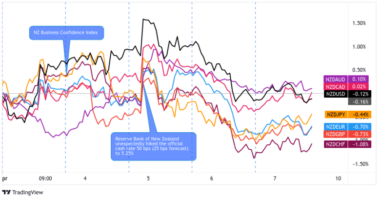The Fed’s preferred inflation measure is coming up!
Will the release make or break the dollar’s intraweek gains?
Here are points you need to consider if you’re planning on trading Friday’s report:
Event in Focus:
U.S. Core Personal Consumption Expenditures (PCE) Price Index for April 2023
When Will it Be Released:
May 26, 2023 (Friday), 12:30 pm GMT
Use our Forex Market Hours tool to convert GMT to your local time zone.
Expectations:
U.S. core PCE price index (m/m): 0.3% forecast vs. 0.3% previous
U.S. core PCE price index (y/y): 4.6% forecast vs. 4.6% previous
Relevant Data Since Last Event/Data Release:
- Retail Sales for April: +0.4% m/m (+0.7% m/m forecast) vs. -0.7% m/m previous
- Producer Prices Index (PPI) for April 2023 was 0.2% m/m (0.1% m/m forecast) vs. -0.4% m/m previous; Core PPI rose by 0.2% m/m as expected vs. 0.0% m/m previous
- Consumer Price Index for April: +0.4% m/m (+0.3% m/m forecast) vs. +0.1% previous; +4.9% y/y as expected vs. 5.0% y/y previous
- ISM Services PMI for April: 51.9 vs. 51.2 in March; Prices Index ticked up 0.1 to 59.6; Employment Index dipped to 50.8 vs. 51.3 previous
- ISM Manufacturing PMI for April: 47.1 vs. 46.3 in March: Prices Index up by 4.0 to 53.2; Employment Index was up 3.3 to 50.2
-
S&P Global US Manufacturing PMI for April: 50.2 vs. 49.2 in March; “input costs and output charges increased at
steeper rates during April.“ - University of Michigan consumer sentiment improved from 62.0 to 63.5 in April
Previous Releases and Risk Environment Influence on the U.S. Dollar
April 28, 2023
Event results / Price Action: As expected, core PCE prices maintained its 0.3% monthly growth in March. The annualized reading came in at 4.6%, slower than February’s upwardly revised 4.7% but higher than the expected 4.5% reading.
Keep in mind that the Fed generally targets 2% based on a broader measure but views the core gauge as a better indicator of the trend.
At the time, the quarterly employment cost index – another preferred Fed measure – exceeded 1.0% estimates at 1.2% in Q1 2023.
The U.S. dollar, which had gained pips after an earlier BOJ announcement and ahead of the core PCE release, dropped across the board at the prospect of the Fed raising its interest rates further despite rising recession odds.
The Greenback also regained its post-report losses in the first hour of the release though the U.S. recession theme stuck and the currency capped the week at new intraday lows except against the yen.
Risk environment and intermarket behaviors: The dollar was seeing choppy price action all week but Friday’s releases underscored the risks of sticky inflation and a hawkish Fed amidst U.S. data misses and rising U.S. recession risks.
March 31, 2023
Event results / Price Action: Core PCE prices rose by 0.3% m/m in February against estimates of a 0.4% uptick and after a downwardly revised 0.5% in January.
The Fed’s preferred annual reading came in at 4.6% – the slowest in 15 months – and further supported speculations that the Fed’s rate hikes are working and that the central bank can soon afford to take the pedal from the metal.
USD dropped to its daily open prices and Asian session support zone at the news. The Greenback regained its knee-jerk losses within the trading session, however, and the currency capped the day mixed against its major counterparts.
Risk environment and intermarket behaviors: Easing banking concerns and strong U.S. data got traders taking risks and pricing in a less hawkish Fed in the week leading to the Friday core PCE release.
A strong PCE reading sustained the dollar’s intraweek downtrends though the currency saw a bit of profit-taking near the end of the trading session and week.
Price action probabilities:
Risk sentiment probabilities:
Markets are generally in a “wait and see” mode right now as traders wait for meaningful progress on the U.S. debt ceiling negotiations.
Optimism for a deal is giving the U.S. dollar a slight advantage among the major assets, however, especially when traders are also pricing in China’s post-lockdown growth possibly peaking as well as the weak PMIs from the U.K. and Euro Area.
U.S. Dollar scenarios:
Potential Base Scenario:
Unless we see concrete updates on the U.S. debt ceiling deal, then we could continue to see risk-takers stay on the sidelines while USD makes slow and steady gains.
A core PCE report that comes in as expected or slightly higher than estimates (as signaled by leading indicators above) may extend USD’s current shallow uptrend after a quick (read: an hour or so) buy-the-rumor, sell-the-news scenario.
In the absence of downside exogenous surprises to spark a risk-averse broad trading environment, consider buying USD against safe-havens like JPY and spot gold.
Potential Alternative Scenario 1:
If U.S. policymakers look like they’re ready to agree on a debt ceiling deal, then we could see risk-taking that may dent on the dollar’s intraweek gains.
It may not matter if the core PCE price index comes in slightly lower or higher than market estimates. Traders could price in their risk appetite and their confidence that the Fed probably won’t tighten that much anyway.
In case of a risk-friendly trading environment during the report’s release, take a look at selling USD against “riskier” bets like AUD, EUR, and CAD.
Potential Alternative Scenario 2:
If the Core PCE comes in far above or below expectations, this may spark traders to focus more on pro/anti-dollar trading frameworks rather than risk-on/risk-off frameworks intraday, barring any major developments on the U.S. debt talks front.
In this scenario, a strong directional bias may develop in the Greenback, but remember that the move may be limited in duration depending on the risk environment at the time of release. If USD is consolidating tightly ahead of the release, look for consolidation breakout setups, especially against gold and JPY IF the U.S. dollar rallies after the event.










